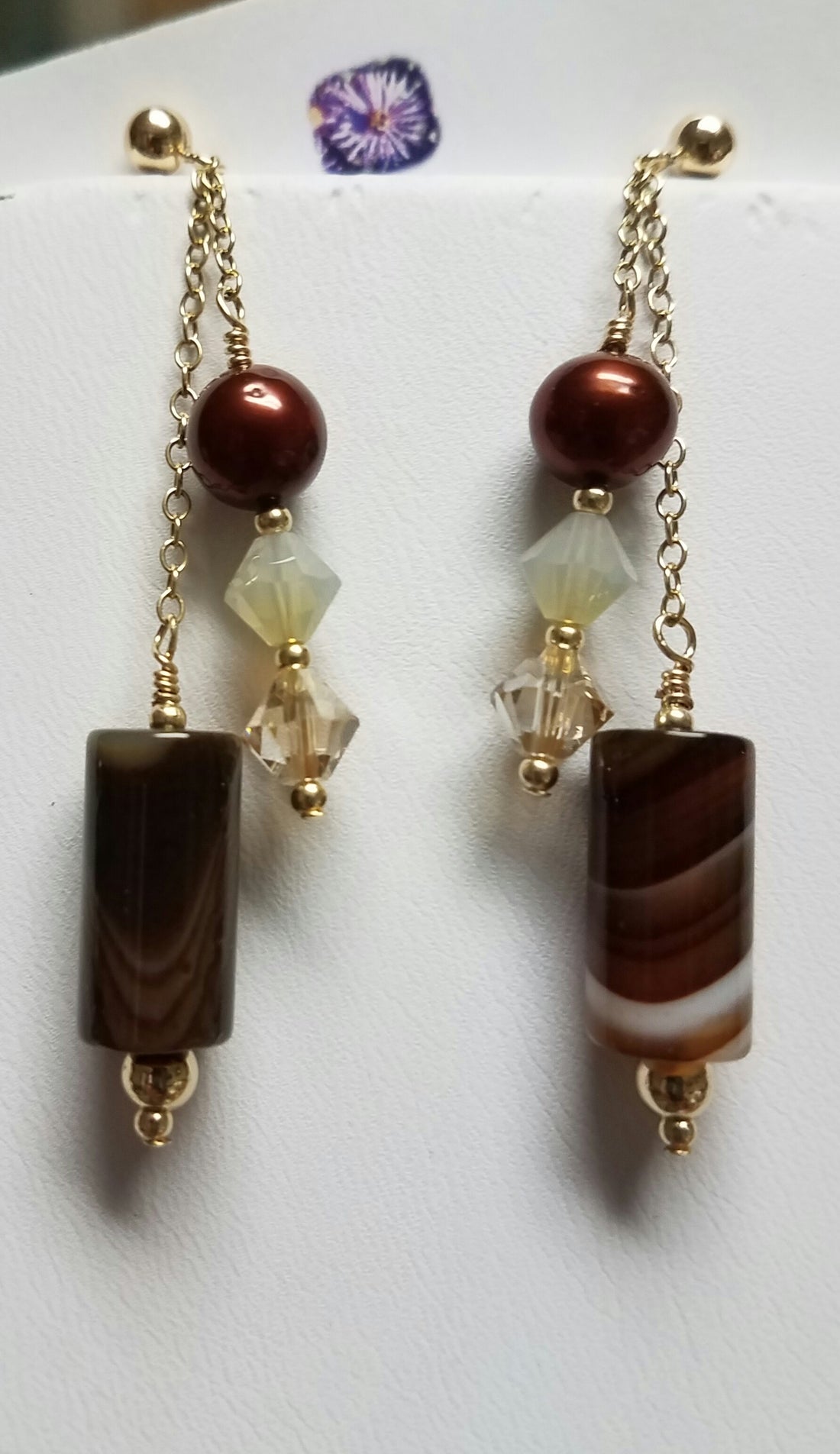
THE DRILL-DOWN ON BOTSWANA AGATE
Share

We’ll start with a very simplified geology crash course. 1. Leads to 2. Leads to 3., etc.
1. Silica - silicon dioxide - according to britannica.com it is one atom of silicon and 2 atoms of oxygen - SiO2 - The mass of the earth’s crust is 59% silica, which is the main constituent of more that 95% of our known rocks.
2. Quartz is crystalline silica which is hard, chemically inert, and has a high melting point. It is the most common form of crystalline silica and is the second most common mineral on the earth’s surface.
3. Chalcedony (the ‘ch’ is a ‘k’ sound) is a microcrystalline or cryptocrystalline form of quartz, meaning made up of crystals too minute to be seen without magnification.
4. Agate is chalcedony with layers of different colors. Think back to last week’s description that onyx has parallel bands while other agates have more chaotic banding.
5. Botswana agate is a banded chalcedony named for Bobonong, Botswana, Africa, where it is mined.
But wait, there’s more . . . however, without bullet points . . .
Agate was formed very slowly over 140-180 million years ago. The hugely varied and unique shape of the banding was produced when slow moving lava flowed through long faults over lower levels of stone. It deposited multiple, successive layers of silica/quartz into cavities in host rock. As the cavities gradually filled, agate was formed. If the cavity was not completely filled, crystalline quartz often filled in. You’ve seen these as geodes cut open to expose the crystals.
Agates are found as small white nodules and must be broken or cut open to expose the striations of color and pattern. And even then they must usually be polished to be found attractive. The use of agate dates back to ancient Greece, where it was named by a Greek naturalist who discovered it along the shore line of the Drillo or Achates River in Sicily sometime between the 4th and 3rd centuries BC.
Different types of agate exhibit different colors and patterns. Botswana agate has banding of white, black, pink, grey, and sometimes muted brown or apricot. It is considered to be the royal member of the agate family. The mining and export of Botswana agate is controlled by the African government.
Metaphysically, it is considered stabilizing, strengthening, balancing, protective, and comforting. In Africa it is valued for power in fertility.
I love the variations in color of agates. And it's just fun to say Botswana, lol! I've used crazy lace agate, blue lace agate, moss agate, and botswana agate. At the moment, I only have two pieces using the Botswana version, both of the golden brown/apricot persuasion. Freshwater pearls and Swarovski crystals are combined with the botswana in each. These featured sets will be 10% off until 11:56 pm on October 14!
1. Silica - silicon dioxide - according to britannica.com it is one atom of silicon and 2 atoms of oxygen - SiO2 - The mass of the earth’s crust is 59% silica, which is the main constituent of more that 95% of our known rocks.
2. Quartz is crystalline silica which is hard, chemically inert, and has a high melting point. It is the most common form of crystalline silica and is the second most common mineral on the earth’s surface.
3. Chalcedony (the ‘ch’ is a ‘k’ sound) is a microcrystalline or cryptocrystalline form of quartz, meaning made up of crystals too minute to be seen without magnification.
4. Agate is chalcedony with layers of different colors. Think back to last week’s description that onyx has parallel bands while other agates have more chaotic banding.
5. Botswana agate is a banded chalcedony named for Bobonong, Botswana, Africa, where it is mined.
But wait, there’s more . . . however, without bullet points . . .
Agate was formed very slowly over 140-180 million years ago. The hugely varied and unique shape of the banding was produced when slow moving lava flowed through long faults over lower levels of stone. It deposited multiple, successive layers of silica/quartz into cavities in host rock. As the cavities gradually filled, agate was formed. If the cavity was not completely filled, crystalline quartz often filled in. You’ve seen these as geodes cut open to expose the crystals.
Agates are found as small white nodules and must be broken or cut open to expose the striations of color and pattern. And even then they must usually be polished to be found attractive. The use of agate dates back to ancient Greece, where it was named by a Greek naturalist who discovered it along the shore line of the Drillo or Achates River in Sicily sometime between the 4th and 3rd centuries BC.
Different types of agate exhibit different colors and patterns. Botswana agate has banding of white, black, pink, grey, and sometimes muted brown or apricot. It is considered to be the royal member of the agate family. The mining and export of Botswana agate is controlled by the African government.
Metaphysically, it is considered stabilizing, strengthening, balancing, protective, and comforting. In Africa it is valued for power in fertility.
I love the variations in color of agates. And it's just fun to say Botswana, lol! I've used crazy lace agate, blue lace agate, moss agate, and botswana agate. At the moment, I only have two pieces using the Botswana version, both of the golden brown/apricot persuasion. Freshwater pearls and Swarovski crystals are combined with the botswana in each. These featured sets will be 10% off until 11:56 pm on October 14!


